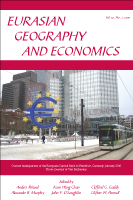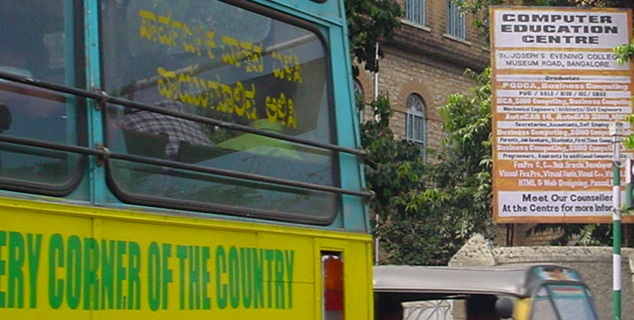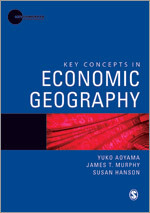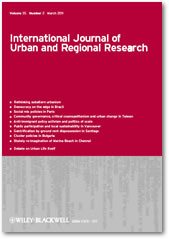Horner, Rory, Seth Schindler, Daniel Haberly, and Yuko Aoyama, 2018. “De-globalization and its limits.” Cambridge Journal of Regions, Economy and Society.
Abstract
https://doi.org/10.1093/cjres/rsx026
Horner, Rory, Seth Schindler, Daniel Haberly, and Yuko Aoyama, 2018. “De-globalization and its limits.” Cambridge Journal of Regions, Economy and Society.
https://doi.org/10.1093/cjres/rsx026
Rory Horner, Ph.D. (Clark, 2013) has been appointed as Lecturer, School of Environment and Development at University of Manchester in United Kingdom! He will be starting his appointment in August. Congratulations, Rory!
Rory Horner won 2013 Peter Gould Student Paper Competition of the Association of American Geographers’ Health and Medical Geography Specialty Group, on a paper entitled
“Rising powers as harbingers of public-health oriented patent law? The Indian pharmaceutical industry and economic geographies underlying health.” Congratulations, Rory!
Rory Horner filed his dissertation entitled “The state, patents, and India’s pharmaceutical industry.” Congratulations, Rory!
Rory Horner won 2013 A.K. Dutt Best Graduate Student Paper Award of the Regional Development and Planning Specialty Group (RDPSG) of the Association of American Geographers. Congratulations, Rory!
Daniel Gray Haberly, Ph.D. (Clark, 2013) has been appointed as Lecturer, Department of Geography at University of Sussex in United Kingdom! He will be starting his appointment in the spring. Congratulations, Dan!
Seth Schindler filed his dissertation entitled “Producing Urban Space and the Transformation of the Retail Sector in Delhi, India”. Congratulations, Seth!
Seth has been appointed as an assistant professor at Global Studies Program, Institute for Asian and African Studies, Humboldt-Universität zu Berlin.
Dan Haberly’s dissertation, entitled “Sovereign Wealth Funds, Dependent Development, and the New Alliance Capitalism” has been filed! Congratulations, Dan!
 Abstract:
Abstract:
India has emerged as a preferred location for corporate R&D and strategic marketing facilities. Until a decade ago, these functions were conducted almost exclusively near the corporate headquarters of MNEs in the developed world. One reason for the relocation of these functions to India is its changing role as a source of market information. With the saturation of the markets in the developed world, MNEs are increasingly interested in cultivating the bottom-of-the-pyramid market, which makes India an ideal location to collect market knowledge. In this paper, we focus on the emerging relationship between markets and MNEs in India. Drawing on interviews with MNEs in Bangalore, we show how the perception of India as a location of innovation has begun to change, and discuss how India has begun to serve as an ideal location for market knowledge gathering activities by MNEs. We argue that their new orientation offers a window of opportunity that has implications for other developing economies, and conclude that India’s unique combination of market assets have played an important role in enabling MNEs to upgrade their functions.
Aoyama, Yuko and Balaji Parthasarathy. “Research and Development Facilities of Multinational Enterprises in India”, Eurasian Geography and Economics, 53, 6 (2012): 713-730

Daniel Haberly was selected as a participant for the Summer Institute of Economic Geography, July 2012.
Rory Horner received the AAG-EGSG research award for his work on the role of state policies in the development of domestic pharmaceutical industry in India. April 2012
Seth Schindler (Yuko Aoyama, PI) has been awarded a NSF-DDRI grant of $11,985 for his Doctoral Dissertation research, entitled “Producing Urban Space and the Transformation of Informal Retailing in Delhi, India”. June 2011
Rory Horner (Yuko Aoyama, PI) has been awarded a NSF-DDRI grant of $12,000 for his Doctoral Dissertation research, entitled “The State, Intellectual Property Rights, and the Rise of India’s Pharmaceutical Industry”. June 2011
Yuko Aoyama (PI) has been awarded a $269,999 National Science Foundation grant for support of the project entitled “The Global Shift in R&D Alliances: Multinational Enterprises (MNEs) and the Quest for the Base-of-the-Pyramid (BOP) Markets.” This grant will support a 3-year project, and will be in collaboration with Dr. Balaji Parthasarathy (Co-PI), the International Institute of Information Technology, Bangalore. June 2011
Daniel Haberly received the EGSG (Economic Geography) Best Student Paper Award at the AAG, Seattle, April 2011.

“Economic Geography sponsored a workshop to brainstorm collectively the emerging research themes in economic geography. We gathered a small group of midcareer scholars from 19 institutions in 7 countries on April 12–13, 2010, in Washington, D.C., to address what we considered a collective concern: that our discipline could use a significant boost in theoretical and thematic developments at this particular juncture. The workshop was intended to be one of the journal’s many contributions to disciplinary activities and ongoing efforts to keep the discipline vibrant for the next generation. The workshop aimed to achieve multiple goals….” [Read on]
Aoyama, Yuko, 2011. “Teleology, Contexts, and Agency in Sheppard’s Socio-Spatial Ontology” Dialogues in Human Geography 1 (March): 76-79.
Daniel Haberly’s forthcoming article in Environment and Planning A, entitled “Strategic Sovereign Wealth Fund Investment and the New Alliance Capitalism: A Network Mapping Investigation”, was ranked No.1 in downloads in Social Science Research Network (SSRN), under the category of journal of INTL: Policy Environment (December 13, 2010 to February 11, 2011).
Seth Schindler was awarded a Geller Award from the George Perkins Marsh Research Institute, Clark University, February 2011.

From the Back Cover:
“This book provides a comprehensive and highly readable review of the conceptual underpinnings of economic geography. Students and professional scholars alike will find it extremely useful both as a reference manual and as an authoritative guide to the numerous theoretical debates that characterize the field.” Professor Allen J. Scott, Department of Geography, University of California, Los Angeles, USA
“This book guides readers skillfully through the rapidly changing field of economic geography. It is a highly readable synthesis of contemporary debates within economic geography that is also sensitive to the history of the sub-discipline.” Dr. Sara Hall, School of Geography, University of Nottingham.
Key Concepts in Economic Geography is a new kind of textbook that forms part of an innovative set of companion texts for the Human Geography sub-disciplines. Organized around 20 short essays, Key Concepts in Economic Geography provides a cutting edge introduction to the central concepts that define contemporary research in Economic Geography. The book includes:
– An introductory chapter providing a succinct overview of the recent developments in the field. Read the Introductory chapter, “What is Economic Geography?”
– Over 20 key concept entries with comprehensive explanations, definitions, and evolutions of the subject
– Extensive pedagogic features that enhance understanding including key points, further reading and section introductions.
An ideal companion text for upper-level undergraduate and postgraduate students in Economic Geography, the book presents the key concepts in the discipline, demonstrating their historical roots and contemporary applications to fully understand the processes of economic change, regional growth and decline, globalization, and the changing locations of firms and industries. Written by an international recognized set of authors, the book is an essential addition to any geography student’s library.
Yuko Aoyama, James T. Murphy, and Susan Hanson are all based at Clark University, USA
Independent Reviews provided as comments to the Sage Publications website:
“The nice thing about this text is that it is concise but with depth in its coverage. A must have for any library, and a useful desk reference for any serious student of economic geography or political economy.” – Dr Adam Dixon, School of Geographical Sciences, Bristol University.
“Book presents in a concise way an efficient explanation of a range of core concepts in economic geography. Individual chapters are very useful for undergraduate students to obtain a better grasp of these concepts. A number of these are discussed in tutorials and students are recommended to include chapters from this book as supplemental reading for these tutorials.” – Dr L. Van Grunsven, Faculty of Geosciences, Utrecht University.
“This book provides an excellent introduction into the spatial dimensions of the economy as well as the economic dimensions of space. I have recommended it to students with special interest in the geographical aspects of economic history.” -Professor Ernst Langthaler, Department for Economic and Social History, University of Vienna.
Rory Horner was selected as a participant for the Summer Institute of Economic Geography, July 2010.
Daniel Haberly (Yuko Aoyama, PI) has been awarded a NSF-DDRI grant of $11,478 for his Doctoral Dissertation research, entitled “Sovereign Wealth Funds, Dependent Development, and the New Alliance Capitalism.” June, 2010.
Aoyama, Yuko, 2009. “Consumption-centered research for diverse urban economies.” Urban Geography 30 No.4: 1-3.
Horner, Rory and Yuko Aoyama. 2009 “Limits to FDI-driven growth in Ireland: A newspaper content analysis for investment, upgrading and divestment.” Irish Geography 42 No. 2 (July): 187-207.
Aoyama, Yuko, 2009. “Entrepreneurship and Regional Culture: The case of Hamamatsuand Kyoto, Japan.” Regional Studies 43 No.3 (April): 495-512.
Rory Horner received the EGSG (Economic Geography) 2009 Best Student Paper Award at the AAG, Las Vegas, NV.
 Abstract
Abstract
In this article, I seek to demonstrate how research on cultural industries and tourism combined yields insights into the contemporary dynamics of cultural survival in the age of globalization. Tourism is increasingly an important economic force that facilitates cultural mobility and promotes cultural consumption, and in turn contributes to the growth of a regionally embedded cultural industry. I take the example of flamenco music and dance in southern Spain and focus on three agents that help shape this art complex — the cultural industry, the tourists and the state. I analyze how these agents interact, and show how their engagements at multiple geographic scales result in a distinctive and successful cultural tourism in Seville, Andalusia. The flamenco art complex survives and thrives today through the combination of resilient local talent closely linked to identity maintenance, domestic and foreign tourists that engage in cultural consumption, and the government subsidizing the artists through state‐sponsored spectacles.
Aoyama, Yuko. 2009. “Artists, Tourists, and the State: Cultural Tourism and the Flamenco Industry in Andalusia, Spain.” International Journal of Urban and Regional Research 33 No. 1 (March): 80-104.

Ratick, Samuel, Brian Meecham and Yuko Aoyama. 2008. “Locating Backup Facilities to Enhance Supply Chain Disaster Resilience.” Growth and Change 39, 4 (December): 642-666.
Aoyama, Yuko and Hiro Izushi, 2008. “User-innovation in the video game industry.” DIME Working Paper. Available at http://www.dime-eu.org/files/active/0/AoyamaIzushiPAPER.pdf
Aoyama, Yuko. 2007. “Oligopoly and the Structural Paradox of Retail TNCs: An Assessment of Carrefour and Wal-Mart in Japan.” Journal of Economic Geography, 7 (July): 471-490.
Aoyama, Yuko and Samuel Ratick. 2007. “Trust, Transactions, and Inter-firm Relations in the U.S.Logistics Industry.” Economic Geography 83 No.2 (April): 159-180.
Aoyama, Yuko. 2007. “The Role of Consumption and Globalization in a Cultural Industry: The Case of Flamenco.” Geoforum 38 No.1: 103-113.